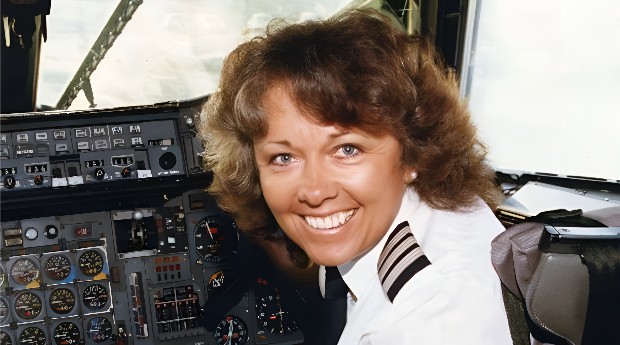Barbara Harmer: The Trailblazing Concorde Pilot Who Changed Aviation Forever

Barbara Harmer was born on 14 September 1953 in Loughton, Essex. Her early life gave little indication of the heights she would one day reach—both literally and metaphorically. Leaving school at just 15, she began her working life in an entirely different field as a hairdresser. Yet even at this young age, Barbara exhibited a streak of independence and ambition that would later define her extraordinary journey.
The world of hairdressing, while creative, offered limited opportunities for someone with Barbara’s restless curiosity and drive. She soon pivoted towards a more technical profession, training to become an air traffic controller. This move planted the seed for what would blossom into one of the most remarkable careers in aviation history.
From Control Tower to Cockpit
While working at Gatwick Airport as an air traffic controller, Barbara began to take flying lessons in her spare time. Earning her private pilot’s licence was just the beginning. She was determined not to remain on the ground, watching others take to the skies. Undeterred by the male-dominated nature of the industry, she pursued her commercial pilot’s licence with unwavering dedication.
It was not an easy journey. At that time, women were vastly underrepresented in the aviation industry. Barbara faced rejection after rejection—over 100 job applications yielded no results at first. But eventually, she secured a position as a flight instructor at Goodwood, and then her first airline job with Genair, flying commuter aircraft.
Joining British Caledonian and Climbing the Ranks
Barbara Harmer’s big break came when she joined British Caledonian Airways. There, she began flying the BAC One-Eleven and later graduated to operating the wide-body DC-10, a large international airliner. This period in her career provided valuable experience in handling complex aircraft on long-haul routes.
When British Caledonian merged with British Airways in 1987, Barbara became one of just a few dozen female pilots out of thousands within the new company. Yet she stood out not just for her gender, but for her competence, professionalism, and ability to inspire others through her work ethic and calm demeanour.
Becoming the First Woman Concorde Pilot
Barbara Harmer’s crowning achievement came in 1992 when British Airways selected her for Concorde conversion training. This was no small feat. The Concorde was not just any aircraft—it was the jewel in the crown of commercial aviation, a supersonic marvel capable of flying faster than the speed of sound. Becoming a Concorde pilot required intense theoretical study and flight simulation, followed by rigorous in-flight training.
After six months of grueling preparation, Barbara completed her Concorde training and made her first flight on the supersonic jet in March 1993. She was the first and only woman in British Airways to fly the Concorde in commercial service, shattering one of aviation’s most exclusive glass ceilings.
A Decade at Supersonic Speed
Over the next ten years, Barbara Harmer flew the Concorde on its flagship route between London Heathrow and New York’s JFK Airport. The flight, which took just over three hours, was a favourite of business leaders, celebrities, and dignitaries. With Barbara at the helm, passengers were often delighted to learn that the pilot flying them at twice the speed of sound was a woman.
Her presence on the Concorde flight deck helped normalise the idea of female leadership in roles that had previously been seen as exclusively male. Her professionalism, attention to detail, and natural authority earned her the respect of her colleagues and the admiration of passengers around the world.
Life Beyond the Concorde
When the Concorde was retired in 2003, Barbara Harmer transitioned to flying the Boeing 777, one of the most advanced wide-body aircraft of its time. Her versatility as a pilot was evident in her seamless adaptation to the newer generation of aircraft technology.
In 2009, she opted for voluntary redundancy from British Airways, ending a distinguished career in aviation that spanned nearly three decades. But retirement from flying did not mean retirement from life. Barbara was also a qualified offshore yachtmaster, a keen sailor, and a participant in numerous yacht races, both as a competitor and as a mentor.
Personal Interests and Quiet Strength
Outside the cockpit, Barbara Harmer was a deeply private and grounded individual. She enjoyed gardening, particularly cultivating Mediterranean plants, and found peace in her seaside home in West Sussex. Her love for nature and her sense of adventure extended to all corners of her life, not just her career.
Despite her ground-breaking status, she never sought fame or accolades. She was content knowing she had earned her place in history and opened doors for others. Her humility and authenticity were just as memorable as her achievements in aviation.
Battling Illness with Grace
In 2010, Barbara was diagnosed with ovarian cancer. She faced this final chapter of her life with the same dignity and resilience that had marked her career. On 20 February 2011, she passed away at the age of 57 at St. Wilfrid’s Hospice in Chichester.
Her passing was mourned not just by her colleagues and family, but by an entire generation of women in aviation who saw her as a role model and a pioneer. Her funeral was attended by friends, former flight crew, and aviation enthusiasts alike, all paying tribute to a woman who had flown higher than most ever dared to dream.
Honours and Legacy
In 2020, a blue plaque was unveiled at her birthplace in Loughton, Essex, to commemorate her achievements and keep her memory alive for future generations. While many female pilots have followed in her footsteps, Barbara Harmer’s place in history is secure. She was the first to shatter the supersonic ceiling, and her trailblazing spirit continues to echo in every woman who takes to the skies today.
Her story is now studied in aviation schools, discussed in equality forums, and referenced in media highlighting women in leadership roles. Barbara proved that excellence knows no gender and that determination, when combined with talent, can break through even the most fortified of barriers.
The Broader Impact on Women in Aviation
Barbara Harmer’s legacy extends far beyond her own flights. She helped change perceptions within a traditionally male-dominated industry. Her success contributed to a gradual but meaningful shift in how female pilots are recruited, trained, and promoted. Today, more women are pursuing careers in aviation than ever before, and part of that progress can be directly traced back to Barbara’s example.
She demonstrated that capability should always be the defining criterion—whether flying at Mach 2 or sailing across oceans. The barriers she broke down have created space for hundreds, even thousands, of women to follow a path once thought inaccessible.
Why Barbara Harmer Still Matters
Barbara Harmer’s life is not just a tale of personal achievement—it is a powerful reminder of what is possible when courage meets opportunity. Her journey from hairdresser to Concorde pilot is proof that life can take extraordinary turns, and that limitations are often illusions.
In today’s world, where gender equality remains an ongoing pursuit, Barbara’s story continues to inspire. Whether you’re an aspiring pilot, a young woman considering a career in STEM, or simply someone seeking a story of resilience, her legacy offers hope, validation, and direction.
Barbara Harmer did not just fly the fastest passenger aircraft in the world—she also helped fast-track social change. Her story is a benchmark for excellence and a beacon for the future of inclusive aviation.



